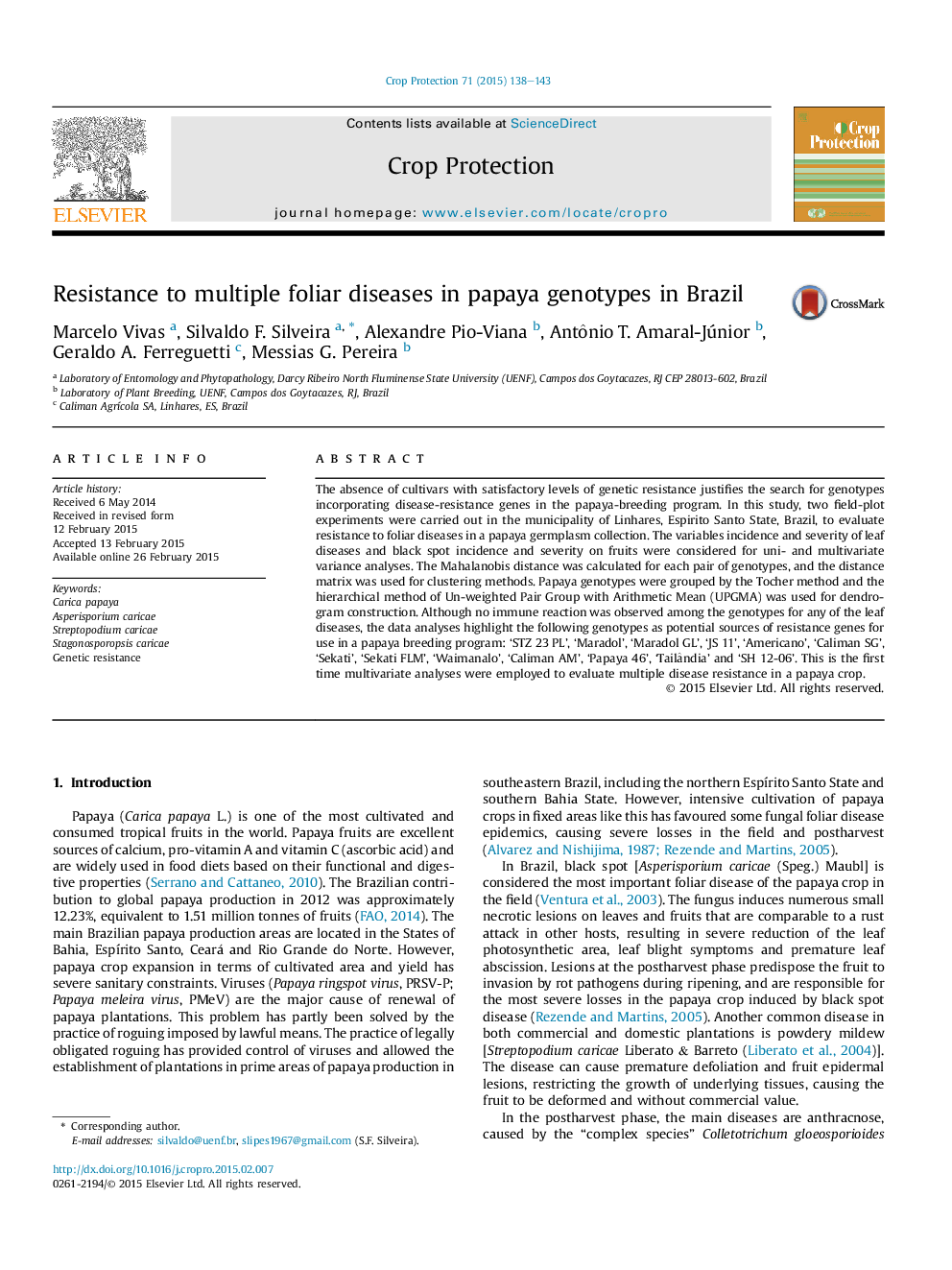| Article ID | Journal | Published Year | Pages | File Type |
|---|---|---|---|---|
| 4505724 | Crop Protection | 2015 | 6 Pages |
•Commercial papaya cultivars resistant to foliar diseases are lacking.•The reaction of papaya genotypes was evaluated in two field plot experiments.•Resistant papaya genotypes to multiple foliar diseases were highlighted.
The absence of cultivars with satisfactory levels of genetic resistance justifies the search for genotypes incorporating disease-resistance genes in the papaya-breeding program. In this study, two field-plot experiments were carried out in the municipality of Linhares, Espirito Santo State, Brazil, to evaluate resistance to foliar diseases in a papaya germplasm collection. The variables incidence and severity of leaf diseases and black spot incidence and severity on fruits were considered for uni- and multivariate variance analyses. The Mahalanobis distance was calculated for each pair of genotypes, and the distance matrix was used for clustering methods. Papaya genotypes were grouped by the Tocher method and the hierarchical method of Un-weighted Pair Group with Arithmetic Mean (UPGMA) was used for dendrogram construction. Although no immune reaction was observed among the genotypes for any of the leaf diseases, the data analyses highlight the following genotypes as potential sources of resistance genes for use in a papaya breeding program: ‘STZ 23 PL’, ‘Maradol’, ‘Maradol GL’, ‘JS 11’, ‘Americano’, ‘Caliman SG’, ‘Sekati’, ‘Sekati FLM’, ‘Waimanalo’, ‘Caliman AM’, ‘Papaya 46’, ‘Tailândia’ and ‘SH 12-06’. This is the first time multivariate analyses were employed to evaluate multiple disease resistance in a papaya crop.
Graphical abstractDendrogram resulting from the analysis of 51 papaya genotypes obtained by the UPGMA clustering method and using Mahalanobis distance as a measure of genetic distance based on multiple disease resistance to the foliar diseases black spot (Asperisporium caricae), phoma spot (Stagonosporopsis caricae) and powdery mildew (Streptopodium caricae). The last five genotypes (‘STZ 23 PL’, Maradol’, ‘Americano’, ‘Maradol GL’ and ‘JS 11’) and the first eight genotypes of group II of the dendrogram (‘Papaya 46’, ‘SH 12-06’, ‘Tailândia’, ‘Sekati’, ‘Sekati FML’, ‘Waimanalo’, ‘BSA’ and ‘JS 12’) could be used for papaya breeding as possible sources of genes for multiple disease resistance. Genetic distances based on data of eight variables of disease intensities: severity and incidence of black spot, phoma-spot and powdery mildew on leaf, and black-spot on fruit. Means calculated from data obtained from two field-plot experiments and two periods of evaluation for each experiment (May and August 2007 and October 2011 and February 2012), of the UENF-Caliman Germoplasm Collection, Linhares, Espírito Santo State, Brazil.Figure optionsDownload full-size imageDownload as PowerPoint slide
